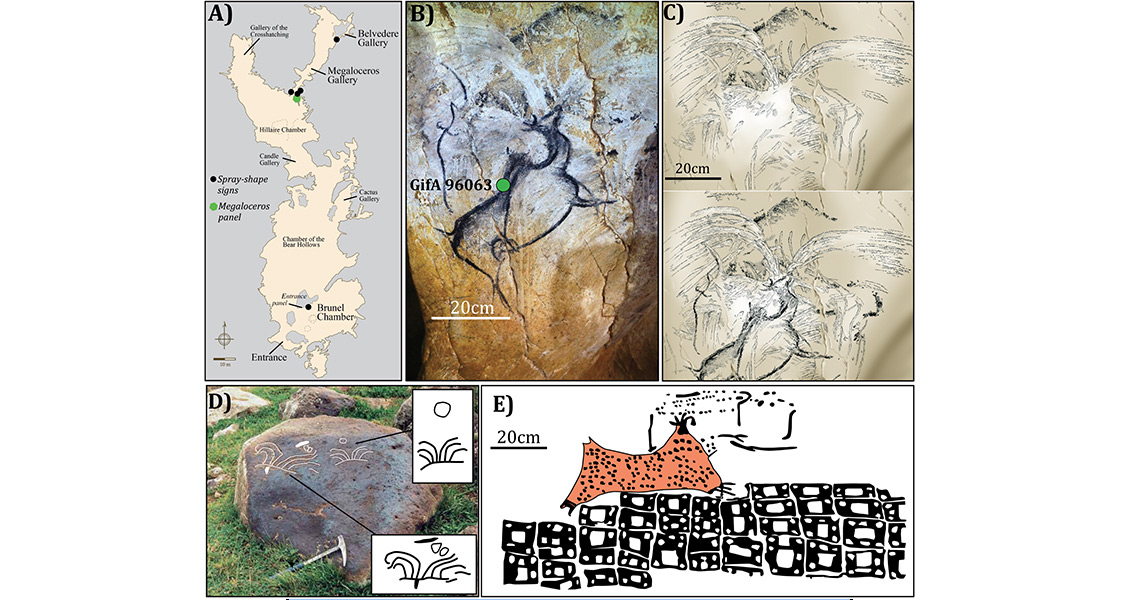<![CDATA[The earliest depiction of a volcano may have been found in the Chauvet-Pont d’Arc cave in Ardèche, France. Popularised in the Werner Herzog documentary 'Cave of Forgotten Dreams', the site of the discovery is one of the oldest Prehistoric cave art sites in Europe, with images dating back up to 37,000 years. Among the depictions of humans and fearsome animals found in the cave are several "peculiar" spray shaped designs. The authors of the new study have documented the occurrence of spectacular volcanic activity just 35km north west of the cave which would have been visible in the hills a short distance from its entrance. As well as raising the suggestion that the Prehistoric inhabitants of what is now southern France depicted natural phenomena such as volcanoes, the research team led by geoscientist at the University of Paris-Saclay in Gif-Sur-Yvette: Sebastien Nomade, has provided the first evidence of intense volcanic activity in the Bas-Vivarais region between 19,000 and 43,000 years ago. Their study was published earlier this month in the journal, Plos One. Radiocarbon dating has dated the oldest occupation and drawings in the Chauvet-Pont d’Arc cave, first discovered in 1994, to between 34,000 and 37,000 years ago. Despite being one of the most spectacular geological events visible on the surface of the earth, volcanic eruptions are rarely found in Paleolithic art. Until now, the oldest testimony of a volcano was believed to be the 9,000 year old Çatalhöyük mural in Central Turkey. The next oldest depiction is roughly 2,000 years younger, and found in Armenia: a group of six petroglyphs in the Syunik upland portraying the eruption of the Porak volcano seven millenia ago. These depictions predate by five millenia the observations and records of the 79 CE Vesuvius eruption made by Pliny the Younger. To put that into context, around 340 Paleolithic sites containing parietal art have been unearthed around Europe, predominantly in northern Spain and southern France. These sites date back to between 36,000 and 40,000 years ago, a period which coincided with the arrival of the first Homo sapiens to the continent. Iconography from the Upper Paleolithic however, largely features images of animals, or in some cases humans. No images of the natural environment, scenery or geological phenomena have ever been discovered. Late last year a study suggested that a depiction of a Paleolithic hunter-gatherer campsite had been discovered in Northern Spain, but these images were dated to 13,000 years ago. In 2012 Nomade visited the Bas-Vivarais region with the aim of dating volcanic eruptions which would have coincided with the initial Homo sapien habitation of southern France. Through measuring the levels of certain isotopes of radioactive argon gas, he determined that the region had been struck by a series of spectacular eruptions between 19,000 and 43,000 years ago. Once it was clear that those living in the Chauvet-Pont d’Arc cave could have witnessed volcanic eruptions just a short distance away, Nomade and his team set about determining that the mysterious, as yet unidentified images in the cave were of volcanoes. The fact that the designs are unprecedented from the time period and region is a key part of the team’s reasoning: “The distinctive design of spray-shape signs specific to Chauvet-Pont d’Arc cave is reminiscent of typical lava fountains associated with strombolian eruptions. Such symbols have no close equivalent within the considered time period (i.e Aurignacian), or even among the more than 340 known ornate caves in France and Spain”, they write in the study. In addition, the iconography of the designs in France bares a resemblance to the petroglyohs depicting the Porak volcano in Armenia. The authors of the study point out that many of the images in the cave tend to be symbolic rather than naturalistic depictions of dangerous animals such as cave lions and bears. As mentioned above, there is no evidence of the inhabitants of the cave depicting scenery. However, the image of the volcano could be interpreted as reflecting a broader fascination with things seen as powerful or threatening. “We must add that as there is no other example in prehistoric rock art of natural scenery it is here perhaps the strength of the eruption image that might have inspired the Aurignacian artists”, the authors write in the study. For more information: www.plosone.org Image courtesy of Plos One ]]>
Cave Art Shows France Ravaged By Prehistoric Volcano
